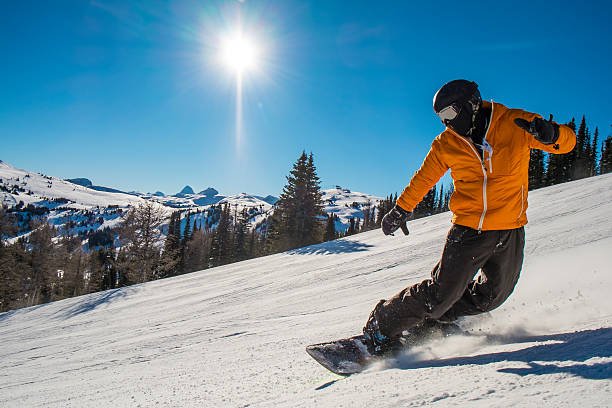Snowboarding, a winter sport that has captivated millions around the globe, is not just about gliding down snow-covered slopes but an exhilarating blend of skill, agility, and adrenaline. This sport, which combines elements of surfing, skateboarding, and skiing, has evolved into a cultural phenomenon with a rich history and a vibrant community. This article delves into the origins, development, techniques, equipment, and the culture surrounding snowboarding, offering an in-depth look at what makes this sport so unique and compelling.

Origins and Evolution of Snowboarding
The roots of snowboarding can be traced back to the early 1960s when Sherman Poppen, an engineer in Michigan, created a toy for his daughter by fastening two skis together and attaching a rope to the front end for control. He called it the “Snurfer” (a portmanteau of snow and surfer). This rudimentary invention laid the groundwork for what would eventually become snowboarding.
The 1970s: Birth of Snowboarding: The 1970s marked the formal birth of snowboarding as we know it today. Innovators like Dimitrije Milovich, a surfer who started making snowboards inspired by surfboards, and Jake Burton Carpenter, who refined and commercialized the snowboard design, were pivotal figures. Burton, in particular, is often credited with popularizing snowboarding by establishing Burton Snowboards, a company that remains a cornerstone of the industry.
The 1980s: Gaining Momentum: The 1980s saw snowboarding gain momentum as a legitimate sport. Early snowboarding pioneers like Tom Sims, who was also a skateboard enthusiast, contributed to the sport’s development by organizing the first snowboarding competitions. Resorts began to open their doors to snowboarders, and the establishment of the North American Snowboarding Association (now known as the United States of America Snowboard and Freeski Association) provided a structured framework for the sport’s growth.
The 1990s: Mainstream Acceptance: The 1990s were a transformative decade for snowboarding, characterized by mainstream acceptance and rapid growth. The International Snowboard Federation (ISF) was founded in 1990, providing international governance. Snowboarding made its debut as an Olympic sport in the 1998 Winter Games in Nagano, Japan, cementing its status on the world stage. This period also saw the emergence of snowboarding legends like Shaun White and Terje Håkonsen, whose skills and personalities helped elevate the sport’s profile.
Techniques and Styles
There are some important and famous techniques :
-
Freestyle Snowboarding: Freestyle snowboarding is characterized by tricks, jumps, and stunts performed on natural and man-made features. This style is popular in terrain parks, which are equipped with halfpipes, rails, boxes, and jumps. Key techniques include grabs, spins, flips, and slides. Freestyle snowboarding is highly creative, allowing riders to express their individuality and style.
-
Alpine Snowboarding: Alpine snowboarding, also known as freecarving, focuses on speed and precision on groomed slopes. This style is akin to slalom skiing, with riders making tight, high-speed turns. Alpine snowboards are typically longer, narrower, and stiffer than freestyle boards, designed to handle high speeds and maintain edge grip.
-
Freeride Snowboarding: Freeride snowboarding is all about exploring off-piste terrain, including backcountry and ungroomed slopes. It combines elements of freestyle and alpine snowboarding, emphasizing adaptability and technical skill. Freeriders often navigate challenging conditions such as deep powder, trees, and cliffs, making it one of the most demanding and exhilarating styles.
-
Boardercross: Boardercross, or snowboard cross, is a competitive discipline where multiple riders race down a course featuring jumps, banked turns, and other obstacles. This style tests a rider’s speed, agility, and ability to navigate a dynamic course with other competitors. Boardercross has gained popularity in recent years and is a regular event in the Winter X Games and the Winter Olympics.
Essential Equipment
Essential Equipment for Snowboarding:
Snowboards: The snowboard is the most crucial piece of equipment, and its design varies based on the riding style. Freestyle boards are shorter and more flexible for maneuverability, while alpine boards are longer and stiffer for stability. Freeride boards strike a balance between the two, designed for versatility in varied conditions.
Bindings: Bindings connect the rider’s boots to the snowboard and play a significant role in control and comfort. There are two main types: strap-in bindings, which use straps to secure the boot, and step-in bindings, which allow the rider to step directly into the binding. Each type has its advantages, and the choice often comes down to personal preference.
Boots: Snowboarding boots are designed to provide support, warmth, and comfort. They come in various flex ratings, from soft to stiff, to match different riding styles. Freestyle riders typically prefer softer boots for flexibility, while freeride and alpine riders opt for stiffer boots for better support and control.
Protective Gear: Safety is paramount in snowboarding, and protective gear is essential. Helmets protect against head injuries, while wrist guards, knee pads, and padded shorts can prevent common injuries from falls. Goggles are crucial for protecting the eyes from snow glare and wind, and they enhance visibility in varying light conditions.
The Culture
The Culture of Snowboarding:
Snowboarding as a Lifestyle: Snowboarding is more than just a sport; it’s a lifestyle that influences fashion, music, and attitudes. The snowboarding community is known for its laid-back, inclusive, and creative ethos. This culture is reflected in the clothing brands, music genres, and media that resonate with snowboarders. Iconic brands like Burton, Volcom, and DC Shoes, along with music genres like punk rock, hip-hop, and electronic, are integral to snowboarding culture.
Competitions and Events: Snowboarding competitions and events play a crucial role in the sport’s community. The Winter X Games, held annually, is one of the most prestigious events, showcasing the best in freestyle snowboarding. The Burton US Open, another major event, draws top talent from around the world. The Olympics also feature snowboarding events, with disciplines like halfpipe, slopestyle, and boardercross.
The Impact of Media: Media has been instrumental in popularizing snowboarding. Snowboarding films and videos, such as “The Art of Flight” and “That’s It, That’s All,” have showcased the sport’s beauty and excitement, inspiring new generations of riders. Social media platforms like Instagram and YouTube have also allowed snowboarders to share their experiences, tricks, and adventures with a global audience.
The Challenges and Future
The Challenges and Future of Snowboarding-
Environmental Concerns: Snowboarding, like all winter sports, faces challenges related to climate change. Rising temperatures and changing weather patterns threaten snow conditions and the viability of ski resorts. The snowboarding community has become increasingly aware of these issues, with many riders and companies advocating for environmental sustainability and taking steps to reduce their carbon footprint.
Accessibility and Inclusivity: While snowboarding has grown in popularity, it remains relatively inaccessible to many due to the cost of equipment, lift tickets, and travel. Efforts to make the sport more inclusive and affordable are ongoing, with programs aimed at introducing snowboarding to underprivileged communities and providing financial assistance to aspiring riders.
Technological Advancements: Technological advancements continue to shape the future of snowboarding. Innovations in board design, materials, and manufacturing processes have improved performance and durability. Additionally, the integration of technology, such as wearable devices that track performance metrics and augmented reality goggles, is enhancing the riding experience and providing new opportunities for training and improvement.
Snowboarding is a dynamic and evolving sport that combines athleticism, creativity, and a deep connection to nature. Its journey from a backyard invention to a global phenomenon is a testament to the passion and dedication of its pioneers and the vibrant community that supports it. As snowboarding continues to grow and adapt to new challenges, it remains a thrilling and inspiring pursuit for those who embrace the mountains and the freedom they offer. Whether you’re a seasoned rider or a curious newcomer, snowboarding has something to offer everyone, making it a sport that truly stands out in the winter landscape.

